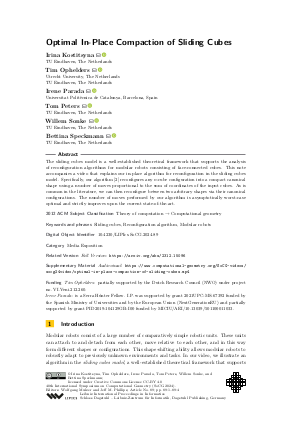Optimal In-Place Compaction of Sliding Cubes (Media Exposition)
Authors
Irina Kostitsyna  ,
Tim Ophelders
,
Tim Ophelders  ,
Irene Parada
,
Irene Parada  ,
Tom Peters
,
Tom Peters  ,
Willem Sonke
,
Willem Sonke  ,
Bettina Speckmann
,
Bettina Speckmann 
-
Part of:
Volume:
40th International Symposium on Computational Geometry (SoCG 2024)
Part of: Series: Leibniz International Proceedings in Informatics (LIPIcs)
Part of: Conference: Symposium on Computational Geometry (SoCG) - License:
 Creative Commons Attribution 4.0 International license
Creative Commons Attribution 4.0 International license
- Publication Date: 2024-06-06
File

PDF
LIPIcs.SoCG.2024.89.pdf
- Filesize: 5.14 MB
- 4 pages
Document Identifiers
Related Versions
- Full Version https://arxiv.org/abs/2312.15096
Subject Classification
ACM Subject Classification
- Theory of computation → Computational geometry
Keywords
- Sliding cubes
- Reconfiguration algorithm
- Modular robots
Metrics
- Access Statistics
-
Total Accesses (updated on a weekly basis)
0PDF Downloads0Metadata Views
Abstract
The sliding cubes model is a well-established theoretical framework that supports the analysis of reconfiguration algorithms for modular robots consisting of face-connected cubes. This note accompanies a video that explains our in-place algorithm for reconfiguration in the sliding cubes model. Specifically, our algorithm [Irina Kostitsyna et al., 2023] reconfigures any n-cube configuration into a compact canonical shape using a number of moves proportional to the sum of coordinates of the input cubes. As is common in the literature, we can then reconfigure between two arbitrary shapes via their canonical configurations. The number of moves performed by our algorithm is asymptotically worst-case optimal and strictly improves upon the current state-of-the-art.
Cite As Get BibTex
Irina Kostitsyna, Tim Ophelders, Irene Parada, Tom Peters, Willem Sonke, and Bettina Speckmann. Optimal In-Place Compaction of Sliding Cubes (Media Exposition). In 40th International Symposium on Computational Geometry (SoCG 2024). Leibniz International Proceedings in Informatics (LIPIcs), Volume 293, pp. 89:1-89:4, Schloss Dagstuhl – Leibniz-Zentrum für Informatik (2024)
https://doi.org/10.4230/LIPIcs.SoCG.2024.89
BibTex
@InProceedings{kostitsyna_et_al:LIPIcs.SoCG.2024.89,
author = {Kostitsyna, Irina and Ophelders, Tim and Parada, Irene and Peters, Tom and Sonke, Willem and Speckmann, Bettina},
title = {{Optimal In-Place Compaction of Sliding Cubes}},
booktitle = {40th International Symposium on Computational Geometry (SoCG 2024)},
pages = {89:1--89:4},
series = {Leibniz International Proceedings in Informatics (LIPIcs)},
ISBN = {978-3-95977-316-4},
ISSN = {1868-8969},
year = {2024},
volume = {293},
editor = {Mulzer, Wolfgang and Phillips, Jeff M.},
publisher = {Schloss Dagstuhl -- Leibniz-Zentrum f{\"u}r Informatik},
address = {Dagstuhl, Germany},
URL = {https://drops.dagstuhl.de/entities/document/10.4230/LIPIcs.SoCG.2024.89},
URN = {urn:nbn:de:0030-drops-200347},
doi = {10.4230/LIPIcs.SoCG.2024.89},
annote = {Keywords: Sliding cubes, Reconfiguration algorithm, Modular robots}
}
Author Details
Funding
- Ophelders, Tim: partially supported by the Dutch Research Council (NWO) under project no. VI.Veni.212.260.
- Parada, Irene: is a Serra Húnter Fellow. I.P. was supported by grant 2021UPC-MS-67392 funded by the Spanish Ministry of Universities and by the European Union (NextGenerationEU) and partially supported by grant PID2019-104129GB-I00 funded by MICIU/AEI/10.13039/501100011033.
Supplementary Materials
References
- Zachary Abel and Scott Duke Kominers. Universal reconfiguration of (hyper-)cubic robots. arXiv e-Prints, 2011. URL: https://arxiv.org/abs/0802.3414.
- Irina Kostitsyna, Tim Ophelders, Irene Parada, Tom Peters, Willem Sonke, and Bettina Speckmann. Optimal in-place compaction of sliding cubes. arXiv e-Prints, 2023. URL: https://arxiv.org/abs/2312.15096.
-
Irina Kostitsyna, Tim Ophelders, Irene Parada, Tom Peters, Willem Sonke, and Bettina Speckmann. Optimal in-place compaction of sliding cubes. In Proc. 19th Scandinavian Symposium and Workshops on Algorithm Theory (SWAT), 2024. To appear.

- Willem Sonke and Jules Wulms. An interactive framework for reconfiguration in the sliding square model (Media Exposition). In 38th International Symposium on Computational Geometry (SoCG), 2022. URL: https://doi.org/10.4230/LIPIcs.SoCG.2022.70.
-
Frederick Stock, Hugo Akitaya, Matias Korman, Scott Kominers, and Zachary Abel. A universal in-place reconfiguration algorithm for sliding cube-shaped robots in quadratic time. In Proc. 40th International Symposium on Computational Geometry (SoCG), LIPIcs, volume 293, pages 1:1-1:14, 2024.

